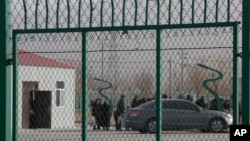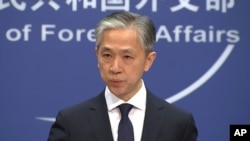Coerced labor among Uyghurs, Kazakhs and other ethnic groups has been taking place in China’s Xinjiang and Tibet, according to a report released by Tomoya Obokata, the U.N. special rapporteur on contemporary forms of slavery.
Special rapporteurs, according to the American Civil Liberties Union, are “independent experts appointed by the U.N. Human Rights Council with the mandate to monitor, advise and publicly report” on human rights situations in specific countries and on human rights violations worldwide.
The report, "Contemporary forms of slavery affecting persons belonging to ethnic, religious and linguistic minority communities,” released Tuesday, found some instances of forced labor in Xinjiang and Tibet “may amount to enslavement.”
“Further, given the nature and extent of powers exercised over affected workers during forced labor, including excessive surveillance, abusive living and working conditions, restriction of movement through internment, threats, physical and/or sexual violence and other inhuman or degrading treatment, some instances may amount to enslavement as a crime against humanity, meriting a further independent analysis,” the report said.
According to the report, China implemented two state-mandated systems to subject local people to forced labor. They include a system through vocational training centers where “minorities are detained and subjected to work placements” and a method of “poverty alleviation through labor transfer” that transfers surplus rural laborers “into secondary or tertiary sector work,” the report stated.
The report also determined a similar forced labor system has been established in Tibet “where an extensive labor transfer program has shifted mainly farmers, herders and other rural workers into low-skilled and low-paid employment.”
Beijing has described these programs as ways to create job opportunities for minorities to enhance their incomes. But the report said the “involuntary nature of work rendered by affected communities" has been present in many cases in Xinjiang and Tibet.
Some think tanks, rights organizations and the U.S. have accused China of Uyghur forced labor in recent years. In June, the U.S. government implemented the Uyghur Forced Labor Prevention Act to ban imports of products related to forced labor from Xinjiang.
Beijing has long denied the accusation of forced labor in Xinjiang and said the labor arrangements in the region are only for poverty alleviation and that people of different ethnic groups can choose their work freely.
Response from US
The Congressional-Executive Commission on China said in a Twitter post that the report “identifies forced labor by Uyghurs, Kazakhs and others as a contemporary form of slavery [and] urges countries to conduct due diligence in supply chains similar to" the Uyghur Forced Labor Prevention Act.
The Washington-based Uyghur Human Rights Project (UHRP) urged the U.N. Office on Genocide Prevention “to immediately assess and respond to the treatment of Uyghurs and other Turkic peoples, in light of the U.N. expert’s report asserting that Chinese government actions may amount to enslavement as a crime against humanity.”
“The case against the Chinese government at the U.N. level continues to build,” UHRP Executive Director Omer Kanat said. “It should now be impossible for U.N. agencies and member states to ignore atrocities of this magnitude.”
Response from China
On Wednesday, Chinese Foreign Ministry spokesperson Wang Wenbin criticized Obokata, saying he had chosen to “abuse his authority, blatantly violate the code of conduct of the special procedure [and] malignly smear and denigrate” China.
A "[c]ertain special rapporteur chooses to believe in lies and disinformation about Xinjiang spread by the U.S. and some other Western countries and anti-China forces,” Wang said at a press conference in Beijing. “There has never been ‘forced labor’ in Xinjiang. The Chinese government follows a people-centered development philosophy and attaches great importance to protecting the rights and interests of workers.”
Last Friday, at a ceremony held at the International Labor Organization (ILO), China’s U.N ambassador ratified two ILO Fundamental Conventions on forced labor.
On Monday, Wang said China’s U.N. permanent representative, Chen Xu, passed the Instruments of Ratification of the Forced Labor Convention and the Abolition of Forced Labor Convention to ILO Director-General Guy Ryder.
“They are the most important international legal instruments in the area of forced labor elimination,” Wang said at a press conference in Beijing on Monday. “The Chinese government is consistently against forced labor. By completing the ratification of the two conventions of its own accord, the government of China has once again made clear its resolute position on opposing and fighting against forced labor.”









